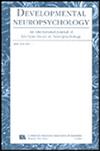The Association of Speech/Language Risk With Phonological Awareness, Rapid Naming, and Reading Ability in Children With Cleft Lip and/or Palate.
IF 2.2
4区 心理学
Q3 PSYCHOLOGY
Developmental Neuropsychology
Pub Date : 2024-03-01
Epub Date: 2024-02-28
DOI:10.1080/87565641.2023.2293715
引用次数: 0
Abstract
Children with cleft lip and/or palate were assessed for speech, language, phonological awareness (PA), rapid naming (RN) and reading ability using standardized instruments at baseline (T1; N = 142, Mage = 6.14 years, 51% males) and 2-year follow-up (T2; 89% retention, Mage = 8.38). Children with no speech or language risk scored higher for T1 and T2 PA, RN, and reading than children with both speech and language risk [Adjusted Mean Difference (AMD) ranged from 11.79 to 21.25]; language risk (AMD 8.37 to 13.58); and speech risk (0.51 to 6.87). No significant differences by cleft type or child sex.
唇裂和/或腭裂儿童的语音意识、快速命名和阅读能力与言语/语言风险的关系。
在基线(T1;N = 142,Mage = 6.14 岁,51% 为男性)和两年随访(T2;89% 保留,Mage = 8.38)期间,使用标准化工具对唇裂和/或腭裂儿童的言语、语言、语音意识(PA)、快速命名(RN)和阅读能力进行了评估。在 T1 和 T2 PA、RN 和阅读方面,无语言或语言风险的儿童得分高于有语言和语言风险的儿童[调整后平均差 (AMD) 在 11.79 到 21.25 之间];有语言风险的儿童(AMD 在 8.37 到 13.58 之间);有语言风险的儿童(0.51 到 6.87 之间)。裂隙类型或儿童性别无明显差异。
本文章由计算机程序翻译,如有差异,请以英文原文为准。
求助全文
约1分钟内获得全文
求助全文
来源期刊
CiteScore
2.80
自引率
6.70%
发文量
17
审稿时长
>12 weeks
期刊介绍:
Devoted to exploring relationships between brain and behavior across the life span, Developmental Neuropsychology publishes scholarly papers on the appearance and development of behavioral functions, such as language, perception, and social, motivational and cognitive processes as they relate to brain functions and structures. Appropriate subjects include studies of changes in cognitive function—brain structure relationships across a time period, early cognitive behaviors in normal and brain-damaged children, plasticity and recovery of function after early brain damage, the development of complex cognitive and motor skills, and specific and nonspecific disturbances, such as learning disabilities, mental retardation, schizophrenia, stuttering, and developmental aphasia. In the gerontologic areas, relevant subjects include neuropsychological analyses of normal age-related changes in brain and behavioral functions, such as sensory, motor, cognitive, and adaptive abilities; studies of age-related diseases of the nervous system; and recovery of function in later life.
Empirical studies, research reviews, case reports, critical commentaries, and book reviews are featured in each issue. By publishing both basic and clinical studies of the developing and aging brain, the journal encourages additional scholarly work that advances understanding of the field of lifespan developmental neuropsychology.

 求助内容:
求助内容: 应助结果提醒方式:
应助结果提醒方式:


